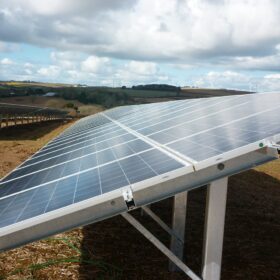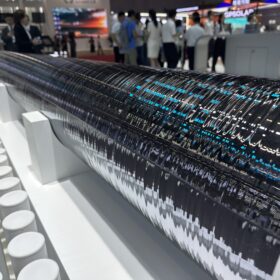Top News
Waaree Solar Americas to invest about $30 million in polysilicon supplier

Awendio Solaris plans multi-gigawatt solar manufacturing hub in Canada

Slovak researchers predict PV inverter output without weather sensors
The pv magazine team wishes you happy holidays and a wonderful start to the new year!

SunRise Arabia Clean Energy Conference 2026
Join the 3rd SunRise Arabia Clean Energy Conference on April 22, 2026, in Riyadh to explore how solar PV and energy storage are powering the Kingdom’s growing digital economy — including data centers. Secure your spot at the early-bird rate.
Battery Business & Development Forum 2026
Connect with Europe’s energy storage leaders at the Battery Business & Development Forum 2026 in Frankfurt (March 31–April 1) and gain insights into evolving business models, financing strategies, and market trends
Out now - pv magazine Global Winter Edition
The new pv magazine Global edition is out now!
Available in print and digital – get your copy today!
Special Edition Genera 2025
On the occasion of Genera 2025, pv magazine is publishing a special edition on the latest developments in the Spanish photovoltaic market.
Content available in Spanish.
Media Kit 2026
Special Edition Energaïa 2025
On the occasion of Energaïa 2025, pv magazine is publishing a special edition on the latest developments in the French photovoltaic market.
Content available in French.

China’s first polysilicon consolidation steps unlikely to move prices in Q1

Poland allocates subsidies to 14.5 GWh of energy storage projects
Schott launches new space solar cover glass
Researchers find sodium-ion batteries using hard carbon anodes can intrinsically charge faster
All solar cell efficiencies at a glance – delayed
Press Releases
Steadfast in ESG Action, Gokin Joins RE100 with 2030 Goal
JDEnergy delivers a 4 MWh C&I energy storage project in Germany
Fox ESS Tops Residential Energy Storage Market Across Europe and Beyond
DAS Solar Secures Fourth Consecutive BNEF Tier 1 Recognition with Global Innovation and Sustainability
Opinion & Analysis
Featured
Solar, wind and storage: stable prices, stable grid
Tracks of low-pressure systems split Europe’s solar performance in November
In a new weekly update for pv magazine, Solcast, a DNV company, reports that Europe’s solar generation potential in November showed a strong east–west split, with Eastern Europe experiencing 15–20% below-normal irradiance due to persistent storms, while much of Western and Central Europe recorded 15–20% above-average levels under clearer conditions. The Atlantic coast was an exception, as Storm Claudia reduced irradiance to near or below average in Portugal, the British Isles, and parts of France and Spain.
‘We have to hire on merit, but ensuring merit is truly visible’
This week, Women in Solar+ Europe features Sonia de Sales, Director of Development at Spain’s Altano Energy. She emphasizes that implementing an equal-opportunities plan is key to ensuring open and fair recruitment, including balanced shortlists and actively sourcing female candidates when they are underrepresented, while hiring on merit and making it clearly visible
China TOPCon cell prices dip despite looming cost pressures
In a new weekly update for pv magazine, OPIS, a Dow Jones company, provides a quick look at the main price trends in the global PV industry.
China module market watches 2026 export rebate signals as polysilicon consolidation platform company is registered
In a new weekly update for pv magazine, OPIS, a Dow Jones company, provides a quick look at the main price trends in the global PV industry.
‘We’re taught to only apply for roles when we can tick every box’
This week Women in Solar+ Europe gives voice to Gemma Buckley, Chief Legal Officer at UK-based Solarport. She says that one of the most persistent barriers wome are witnessing is how they are socialised. “Research shows men apply for promotion or a new role when they’re 60% qualified; women wait until they’re 100% qualified. I’ve watched this play out throughout my career,” she states.
Markets & Policy
Featured
Engie to power Australian cricket matches with GreenPower
UK added at least 2.5 GW solar in 2025, revised data reveals
Provisional capacity data updated with 1.5 GW of solar added to total deployment figure. New capacity additions include largest solar plant to date and a record year for rooftop installations.
SPIE signs Tesla framework deal for European battery storage projects
France-based SPIE has signed a three-year framework agreement with Tesla to deploy Megapack technology across European battery energy storage projects, including a 1.4 GWh facility in the Netherlands.
India passes 132.8 GW of installed solar capacity
India’s installed solar capacity reached 132.85 GW at the end of November 2025, led by utility-scale projects in Rajasthan, Gujarat and Maharashtra, according to the central government.
US researchers use machine learning to detect hidden solar array defects
US researchers say a self-supervised machine-learning tool can identify long-term physical defects in solar assets weeks or years before conventional inspections, potentially reducing operations and maintenance costs.
Clivet releases residential air-to-air heat pump
The Italian manufacturer said its new Fullness heat pump system has a coefficient of performance of 2.8 and a seasonal energy efficiency ratio of 3.79.
Installations
Featured
Ambrion launches new all-in-one storage solutions
Rooftop bifacial PV can produce over 9% more power than monofacial systems in high-latitudes
A study analyzing urban bifacial PV systems in high-latitude areas found they can generate 9–13% more electricity than monofacial panels under snow conditions, particularly in winter, while also achieving a lower levelized cost of electricity. The research developed a techno-economic optimization model considering snow effects, panel orientation, interrow spacing, and operation modes, highlighting sensitivity to market conditions and discount rates.
Canon testing solar at Japanese data center
Canon IT Solutions has begun testing a solar PV system to power its Tier 4 data center in Nishitokyo, aiming to boost renewable energy use and reduce costs. The system is expected to generate around 69 MWh annually and enhance power resilience during emergencies.
Rute SunTracker opening cattle grazing land to solar power
The company deploys first commercial tracking system with a 13-ft. clearance hardened against wind and beef.
Greek solar producers petition EU over repowering and storage rules
Two complaints to the European Commission allege Greek repowering policies and high performance bonds for battery storage projects block upgrades, raise costs, and hinder energy transition, according to industry association Pospief.
Amea Power begins construction on 1 GW/600 MWh solar-plus-storage plant in Egypt
According to the developers, the $700 million giant project will be Africa’s largest single-site hybrid renewable facility. Amea Power began construction before financing was completed.
Technology
Featured
Aiko achieves 24.8% efficiency in commercial solar module production
Europe’s first sodium-ion cell made with fully domestic components
Welsh battery breakthrough uses UK-manufactured anode and cathode materials as well as active materials available through local supply chains. Batri plans to scale up material manufacturing and cell building capability.
French testing body flags durability risks in TOPCon solar modules
Accelerated testing by French certification body Certisolis finds wide performance divergence and design vulnerabilities in tunnel oxide passivated contact (TOPCon) solar modules that current international standards do not capture.
Chinese scientists unveil thermoacoustic ultra-high temperature heat pump prototype
Researchers at the Chinese Academy of Sciences developed a thermoacoustic Stirling heat pump prototype that offers high thermal performance, a peak coefficient of performance of 1.68, and potential applications in high-temperature industrial processes, enabling zero-carbon heating for sectors like petrochemicals and metallurgy.
The impact of transparent conductive electrodes on perovskite-silicon tandem solar cell performance
An Oxford researcher has found that transparent conducting electrodes can reduce perovskite–silicon tandem solar cell efficiency by over 2%, with losses linked to electrical resistance, optical effects, and geometric trade-offs. Using a unified optical–electrical model, the scientist showed how careful optimization of TCE stacks, coatings, and cell design is critical to closing the gap toward the 37%–38% efficiency frontier.
Incat powers up world’s largest battery-electric ship
Australian shipbuilder Incat Tasmania has powered up the world’s largest battery-electric ship – and the largest electric vehicle of any type on the planet – and successfully completed its first e-motor trial in Hobart.
Manufacturing
Featured
European solar manufacturers urge Italy to revise heterojunction tax rule
Longi backs Carbon’s shift to GW-scale solar production in France
France-based startup Carbon plans to partner with Chinese manufacturer Longi and adopt back-contact (BC) solar technology as it revises its roadmap for a gigawatt-scale solar module factory.
JA Solar joins consortium building $210 million PV module factory in Egypt
The 200 square meter facility is targeting an annual manufacturing capacity of 2 GW of solar cells and 2 GW of solar modules. The solar cell production will be 100% for export.
Wood Mackenzie predicts 2-year decline in global solar inverter demand
Wood Mackenzie’s latest analysis expects market uncertainty in China, Europe and the U.S. to cause two consecutive years of contraction in the global solar inverter market, forecasting a fall to 577 GWac this year and 523 GWac in 2026.
Ecoprogetti ramps up solar module production line in Oman
Italy’s Ecoprogetti has delivered a 400 MW fully automated solar module production line in Oman. The facility is the company’s second in the country, which it says equates to a majority share of Oman’s module manufacturing market.
France pulls reduced VAT status from four DMEGC solar modules
France’s certification body says it has withdrawn eligibility for a lower solar VAT rate from four Chinese-made modules after finding traceability errors that altered their carbon footprint calculations.
Energy Storage
Featured
Saudi Arabia connects 7.8 GWh battery storage project to grid
Geon launches new inverter battery for residential, commercial use
The Indian manufacturer said its new Geon Gelithium series is an efficient back-up solution for homes, clinics, small retail outlets, offices, and light commercial applications. The system is available in two versions with an inverter rated capacity of 1,250 VA and 2,500 VA, respectively.
‘The real cost of a battery storage goes far beyond $/kWh’
During a pv magazine Week Europe 2025 webinar, storage specialists gave their thoughts on what to consider when purchasing battery energy storage systems in Europe, with pricing, supplier options and product reliability all on the agenda.
US energy storage installations surpass 2024 total by Q3 2025
US energy storage deployments exceeded full-year 2024 levels within nine months, led by utility-scale projects and sustained residential growth, according to industry data.
Bulgarian tender awards more than 4 GWh of energy storage capacity across 31 projects
Bulgaria’s second standalone energy storage procurement exercise of 2025, worth close to BGN 229 million ($137.2 million), received a lot of interest and there are 30 project proposals included in a reserve list, the government said.
Romania commissions 400 MWh battery storage project, its largest to date
Nova Power & Gas’s 400 MWh project in Cluj County is the largest battery energy storage system (BESS) to date to have been connected to Romania’s grid.







